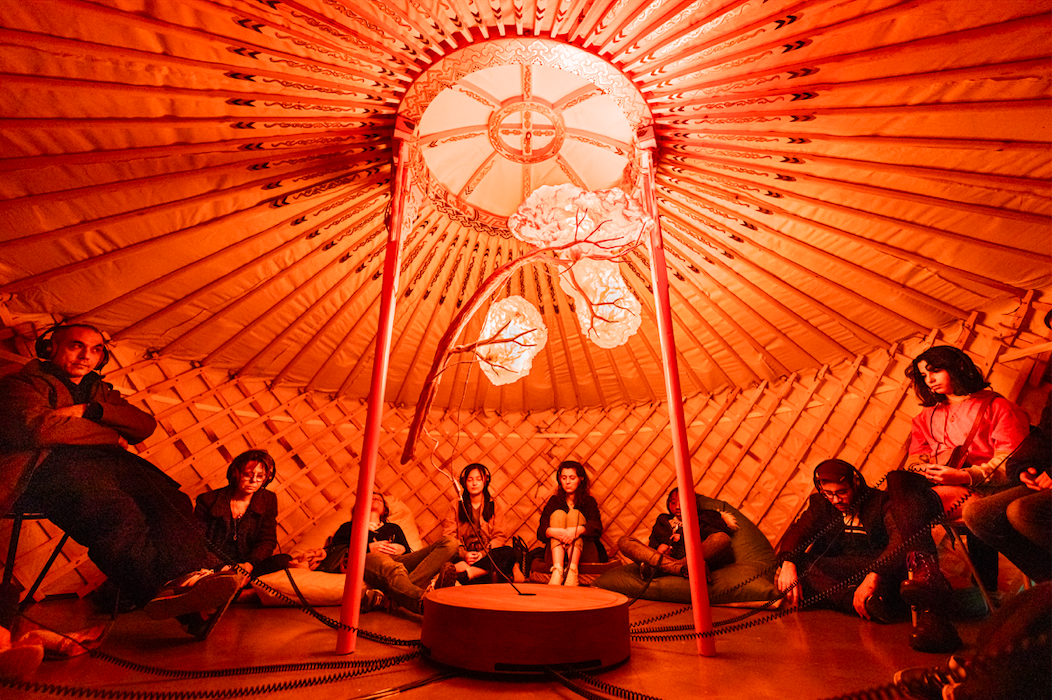Despite being more constantly connected than ever thanks to the little black squares in our pockets, we also live in a time where we’ve never felt more disconnected from ourselves, the collective, and our planet.
We can recognise the names of brands from their logos… but can’t recall the names of trees from a picture of their leaves.
So creating experiences that take care of us, recreate a feeling of connection, and help us move toward a brighter future seems more and more important.
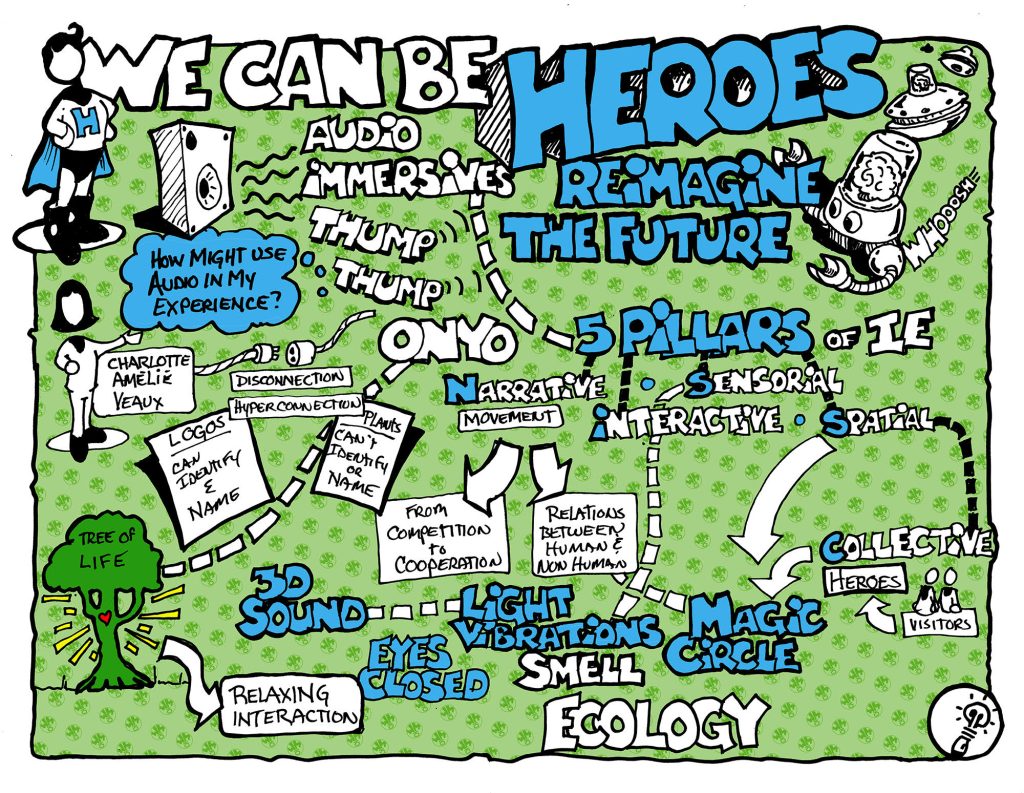
Enter “regenerative experiences”.
Just like the regenerative travel movement seeks to not only have a minimal impact on the environment, but also leave a destination in a better place than travellers found it, regenerative experiences aren’t just about creating a moment in which our audience feels relaxed or has fun. Instead, they offer them a space to explore alternative narratives in a soft, caring way, nurturing a more positive mindset to enact future change.
Charlotte-Amélie Veaux, Co-Founder of Onyo, creates immersive experiences that sit at this crossroads between art, ecology and wellness. Her and her partner Yann Garreau travelled the world for over a year, visiting 15 countries and testing over 100 immersive experiences to figure out how we might create experiences to fix this feeling of disconnection. The result was The Tree of Light, an immersive audio experience that encouraged participants to rethink their relationship with the natural world.
Here she shares the 5 ways to make an immersive experience that she discovered, as well as how we might create regenerative experiences that offer a different story of what’s possible and where everyone is the hero. Because if we can’t imagine a better future, how can we make it happen?
We’re Living In A State Of Permacrisis. So What’s Next?
It’s impossible to avoid the effects of the climate crisis, which are visible all around us. Biodiversity is falling and natural disasters are on the rise. Meanwhile, a host of other crises are contributing to a general rise in anxiety, such as the pandemic and wars.
The result is a strange feeling of both hyper connection and disconnection at all levels of society. On the one hand, we’re swamped with data and information. On the other, we feel overwhelmed, confused and lost about what to do with it all. This sense of being hyper connected to each other through screens but disconnected in reality was only enhanced by the pandemic, when much of everyday life moved on screen.
“Being together feels harder and harder. There’s more and more distance between opposites.”
Charlotte-Amélie Veaux
We’re so disconnected from nature in particular that we talk about it as if we exist in opposition to it. However, humans are as much a part of nature as the rest of the planet. When we talk about climate, we’re talking about our home – and if wildlife disappears, we will, too.

So how do we reconnect – not only with the biodiversity of our environment, but with others around us and ourselves?
The 5 Pillars Of Immersive Experiences
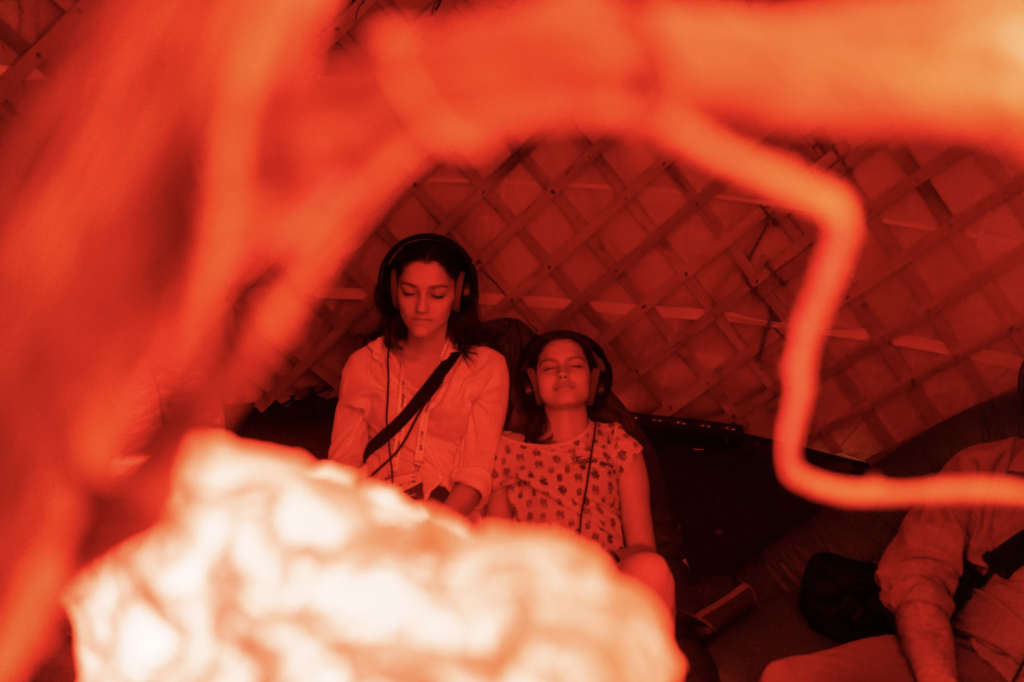
To answer this question, Veaux set out to create an immersive and regenerative experience.
She and Garreau began with a world trip in 2019 across 15 countries, from North and South America to Asia and Europe. They also tested online experiences during the lockdowns and read scientific literature. Their research took in as many different fields as they could find, from art and museums to tourism, entertainment, training, theatre and gaming.
The result of all their work were the 5 pillars of immersive experiences. To create an immersive feeling, you must have one main pillar, and build on the rest. And while you don’t necessarily need all five pillars to create an immersive experience, the more you can touch on, the more likely you are to succeed.
The 5 pillars they identified were:
- Story
- Interactive
- Senses
- Spatial
- Collective
When designing the first Onyo experience, The Tree of Life, Veaux wanted to play with all five pillars, using what they had learned from their research to deepen the impact of the experience. Here’s what she did.
1. Story: Flipping The Archetype
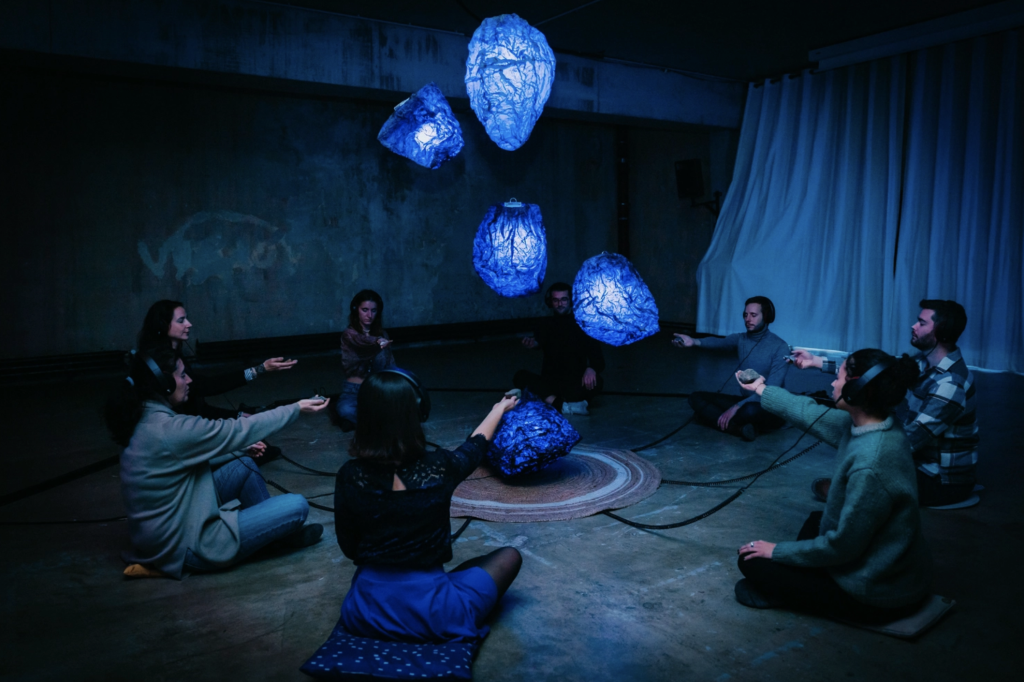
The overwhelm and disconnect that we feel in modern life has created a crisis of imagination. It’s become easier to picture the end of the world than a future in which we respect the planet’s boundaries. We therefore need a new narrative movement to help us tell different stories and create a picture that is desirable.
To achieve this, Veaux wanted to dive into fantasy and the marvellous, avoiding negative questions and asking deeper ones, instead. She found that by questioning the traditional way we tell stories and even flipping it on its head, she was able to navigate towards a new kind of storytelling better suited to optimism and collective progress.
- Changing the hero archetype.
In principle: The Hero’s Journey teaches us that there’s one single hero and a single antagonist, who come into violent conflict. Instead, Veaux wanted to highlight not a single hero, but a collective one. The audience all become the heroes, acting together to achieve an outcome.
In practice: in the Tree of Life, every audience member has to perform a ritual to regenerate the tree.
- Moving from competition to cooperation.
In principle: in nature there is competition, but there’s also a lot of cooperation. We can achieve incredible things when we work together: so rather than telling a story of opponents fighting for victory, let’s tell one of people working in harmony.
In practice: in the Tree of Life, the ritual will only work if everyone participates and contributes.
- Defining new relationships between the human and non-human.
In principle: we usually say “animals” to mean any wildlife except humans – but we are animals, too. And nature isn’t a resource for our disposal, it’s something we are part of. The story should shift our current point of view in this direction.
In practice: in the Tree of Life, the story tells us that everything on Earth was created when the spirit of the Sun put a part of herself into the Tree, from mushrooms to human beings.
2. Interactive: A Relaxing And Regenerating Interaction
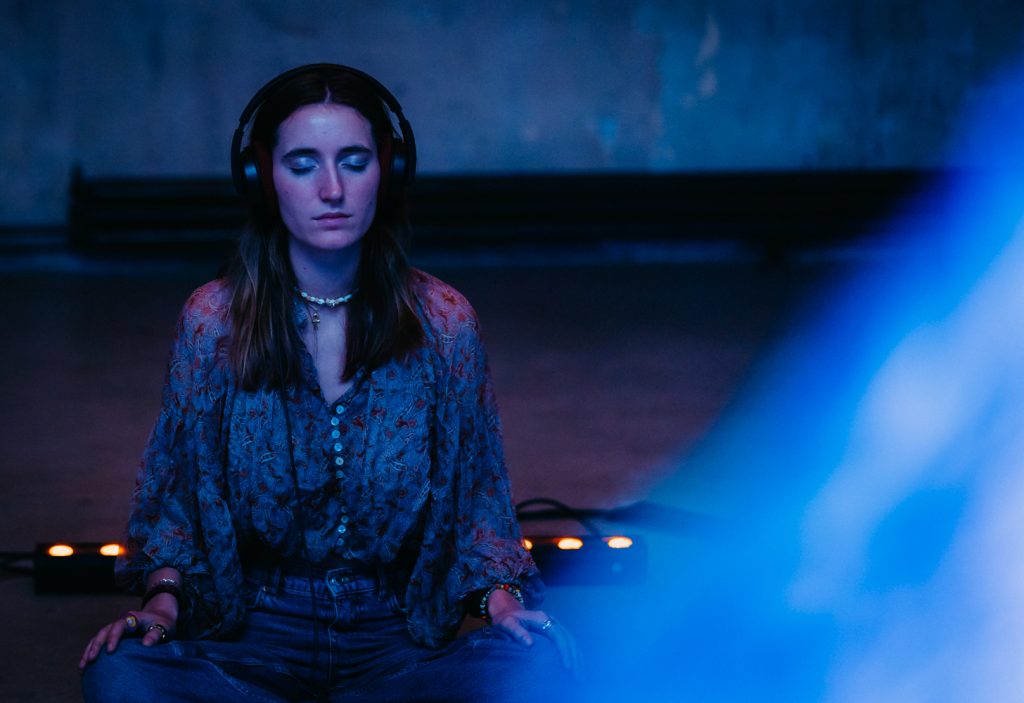
At the heart of The Tree of Life is the regenerating ritual that the audience must perform to re-energise the Tree. Veaux designed this to be not intrusive or uncomfortable, but a gentle and collaborative interaction.
The key part of the ritual is a breathing exercise where the audience blows on to the “embers” of the Tree. This is inspired by meditation and performed collectively, having a physical as well as an emotional impact.
By using something familiar and simple that people could choose to do either subtly or strongly, audiences feel comfortable to participate at their own pace.
3. Senses: Reconnecting With Our Bodies To Alight The Soul
Although The Tree of Life is mainly an audio experience, Veaux defines it more broadly as a “sensorial experience” designed to help audiences reconnect with their senses and bodies.
When it comes to subjects like ecology, we traditionally think with our brains rather than our bodies or hearts. Stimulating the senses can help to trigger a deeper emotional connection.
- An eyes-closed experience. This means that everyone can imagine a different story or environment. When told that they were in a forest, some people pictured woods from their childhood, and others the jungle from Avatar. (Read more on The Visionary Power Of The Eyes-Closed Experience here.)
- 3D sound. All participants have to wear individual headphones and the experience uses binaural sound so that the experience feels internal and intense. This also protects participants from laughter or people who aren’t into the experience. (Read more on Good Vibrations & Brain-Boosting Audio Experiences here.)
- Light, vibrations and smell. The Tree has a light that changes through the experience and can be seen through your eyelids – for example, when you blow on the Tree the light intensifies, making you feel like you’re having a real impact. It also uses haptic vibrations and a small amount of sheep scent from the yurt surroundings.
Touch can also have a powerful effect on the impact of an experience – see the ASMR experiences pioneered by Whisperlodge. In the case of The Tree of Life, Veaux chose not to include touch as you’re already asking for a lot of vulnerability from participants by asking them to close their eyes and let go among strangers. Touch can feel very intrusive in this context, particularly if you didn’t see it coming – it might cross that line of emotional safety. (Although we’d also argue that challenging feelings can sometimes be pivotal in triggering transformation – after all, it’s one of the main conditions for flow.)
4. Spatial: Keeping It Low Tech For A Lighter Footprint
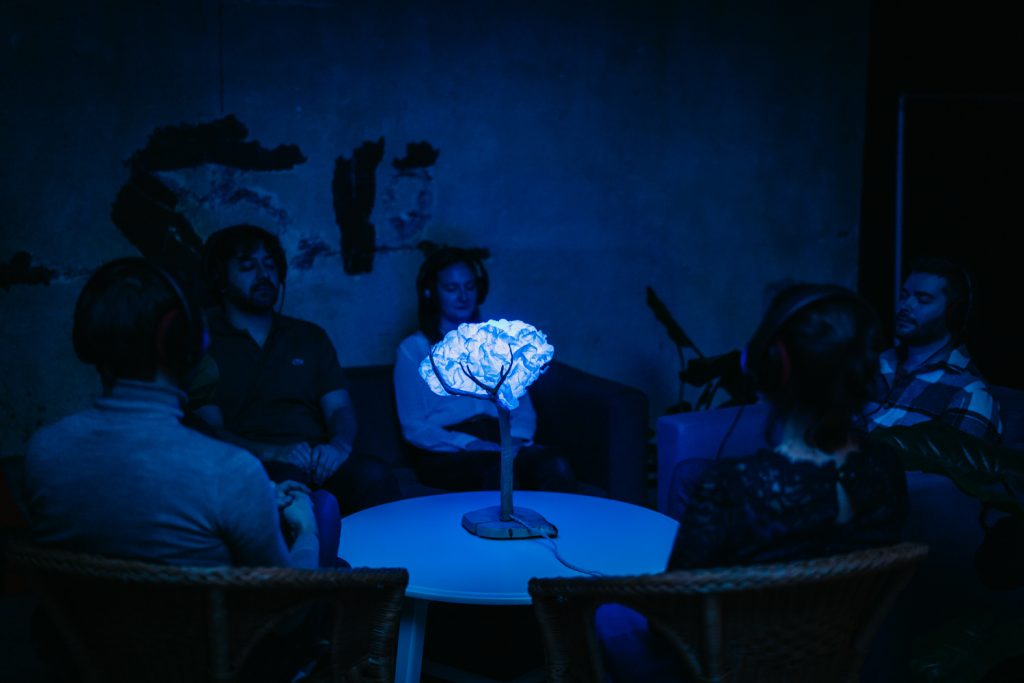
The setup of your experience is another crucial element in creating that immersive feeling. For the ecological message of The Tree of Life, Veaux wanted the experience to feel lo-fi, but high impact, favouring the handmade and time-worn to an abundance of new technologies.
- The main format of the experience was a magic circle, a concept used in many different fields to help create community – see the Nomadic School of Wonder, the round setup of Dreamachine, or the inspiration for our very own Campfires! No-one is any closer to the centre than anyone else, and it reminds us of ancient rituals.
- To make it clear that you’re about to experience something different from the everyday, The Tree of Life takes place in a Mongolian yurt, a physical bubble that marks the crossing of a threshold.
- The yurt and the Tree itself are made by craftsmen. Each will be different and flawed, the same way that real life is. They also help to create an ancient, magical feeling and keep the footprint of the experience low, as they can be reused without waste.
- Any tech is completely hidden. The aim isn’t to be complimented on the tech, but on the moment of emotion created.
- The experience was kept deliberately small, to groups of around 12 people, so the creators could easily move towards the audience.
Giving the right information to people before they enter an experience can also completely change the way they experience.
“If you take the same content and shift the context, you create a different setup. If you tell people on safari that the animals are out to get them, they will experience it differently. Similarly, if you take psychedelics, the environment and setup are as crucial to your experience as the drug itself. In the context of experiences, this could be used to encourage repeat visits.”
Doug Steel
5. Collective: Creating A Collective Moment
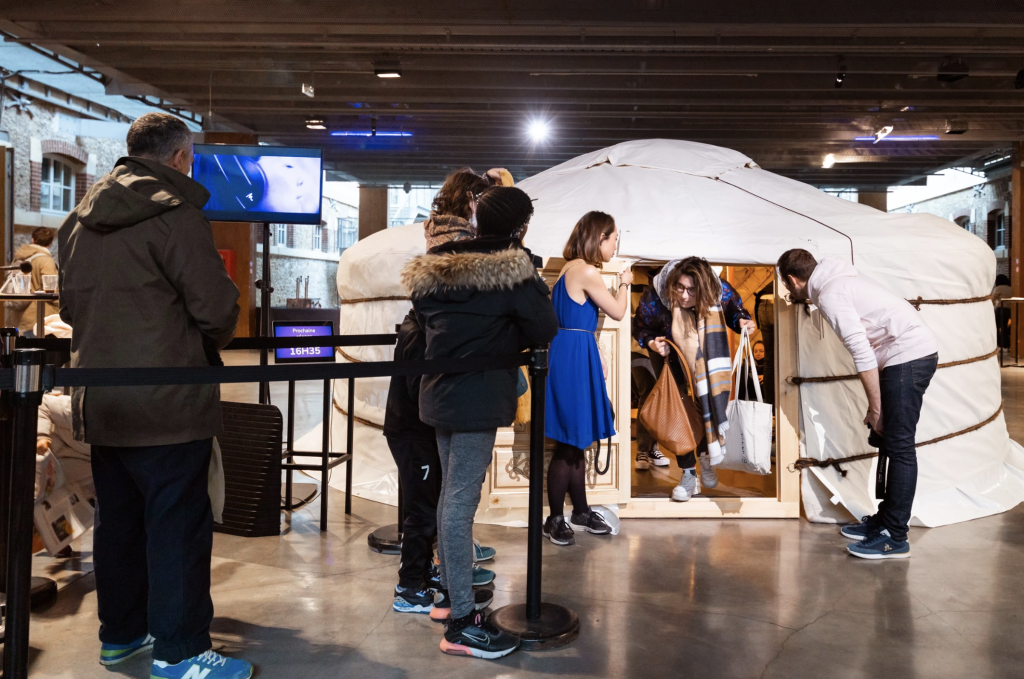
The Tree of Life is designed for 12 people, but you can also use it for larger or smaller groups. To bond participants together and create a collective moment, it’s not only the duration of the experience that matters, but also the pre and post elements.
Before the experience, participants put on their headphones and someone performs a pre-ritual by telling a story that prepares them for what’s about to happen. This is reminiscent of being a child, putting them in a receptive mindset.
During the experience, the circle format is important for establishing a lack of hierarchy. When wearing their headphones, the audience can also hear “fake” participants reacting to the ritual, to remind them that they’re not alone.
After the experience, participants are given time to absorb before they take off their headphones. There’s then a few seconds of silence to hold the space, before they’re invited to share their experience, verbalise what they felt and hear people respond. The most common emotions that come up are relaxed, at peace, optimistic, and with a feeling of connection and wonder.
What’s The Impact Of A Regenerative Experience?
By fulfilling these pillars, how far does The Tree Of Life move towards the purpose of a regenerative experience: to shift participants towards a more positive mindset?
- The experience addresses the hard questions. No one has the answer to how we might build a sustainable future, but when we address these questions collectively, we can start feeling better.
- It reminds us that we’re not on our own, that we can connect to our emotions, and that we can make real change.
- It shows us that it’s possible to create an immersive experience with a low footprint.
- It proves that we can address complicated and stressful subjects like ecology in a way that people enjoy.
And while we can’t prove that the experience will lead to real transformation, it opens a door to it by showing how connecting with other participants can make you feel good.
“Research shows that if you move people away from being materialistic, they become more pro-social.”
James Wallman
To evolve the concept, in the current Onyo experience, Guardians of the Mountain, and the forthcoming experience, Song of the Iceberg, Veaux wants to explore working with larger groups, creating an at-home version of the experience, and making it more interactive, potentially by having them moving around and with eyes open.
The WXO Take-Out
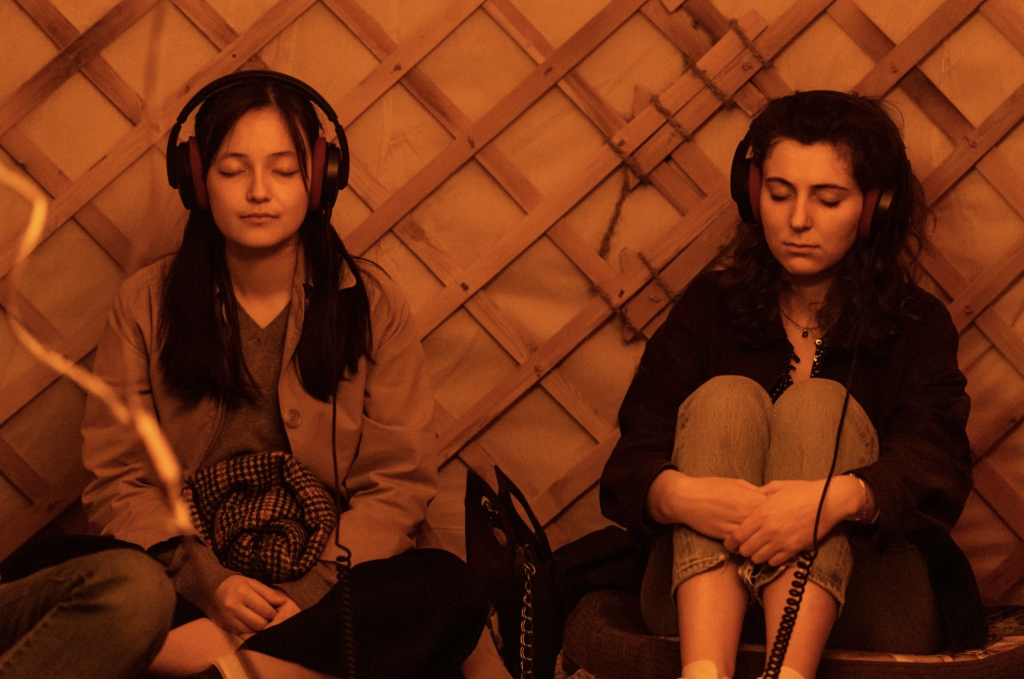
We often think that in order to change people’s beliefs, we have to try and change their behaviour. But this is really hard to do, and to maintain!
The beauty of a regenerative experience like The Tree of Life is it shows that we can change people’s beliefs not through behavioural change, but through something as simple as an experience. The power of reconnecting with our imagination can have a real impact, and help turn people from a group of individuals into a collective who can take real action.
It’s also another example of how effective rituals can be within your experience, as well as further evidence of the rise of functional experiences.
So next time you’re designing an experience, ask yourself:
- What are the narratives behind your experience – both the storytelling and brand, but also the actual model?
- How do you design for collective moments, taking individuals that come in and turning them into a collective?
- As an experience designer, what new narratives do you need to create?
To see the full line-up for the WXO Campfires Season 6, click here.
To apply to join the WXO and attend future Campfires, click here.

